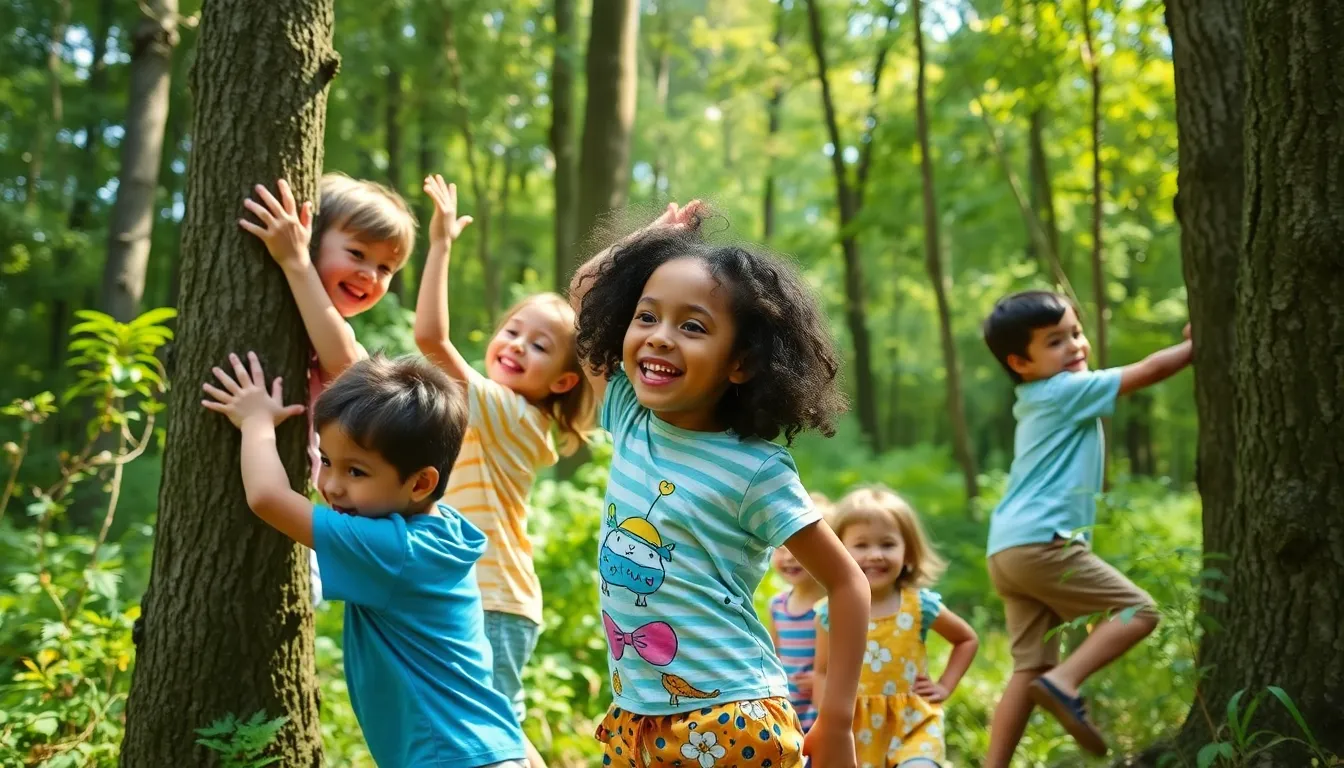Table of Contents
ToggleImagine a classroom where the walls are made of trees, the desks are logs, and the only homework is climbing a tree. Welcome to the world of forest schools, where education meets adventure in the great outdoors. These innovative learning environments are turning traditional education on its head, encouraging kids to swap textbooks for nature trails and lectures for leaf identification.
In forest schools, children thrive in a hands-on setting that fosters creativity, resilience, and a lifelong love for the environment. With every mud pie and bug discovery, they’re not just learning; they’re growing. Who knew that getting dirty could be the secret ingredient to a well-rounded education? As more parents and educators embrace this refreshing approach, it’s clear that forest schools are more than just a trend—they’re a movement toward nurturing curious minds in the wild.
Overview of Forest Schools
Forest schools embrace outdoor education by replacing traditional classrooms with natural settings. Children experience hands-on learning through direct interaction with the environment. Curiosity drives exploration, allowing kids to climb trees, build shelters, and observe wildlife. Each activity fosters essential life skills such as teamwork, problem-solving, and resilience.
Programs often feature a child-led approach, encouraging autonomy and decision-making. In these environments, children set their pace for learning, with educators guiding rather than directing. While engaging in nature-based activities, children develop a sense of responsibility toward the environment.
Research demonstrates that forest schools significantly boost emotional and physical well-being. They promote physical fitness through active outdoor play and enhance mental health by reducing stress levels. Over 80% of parents report improved confidence and social skills in children attending forest schools.
Inclusivity is a core principle of forest schools. Children of all backgrounds and abilities can participate, ensuring a diverse learning community. Social interactions flourish, helping children build friendships and learn from one another.
Moreover, educators receive training to create safe and stimulating outdoor spaces. Risk assessments guide activities, balancing adventure and safety. By prioritizing experiential learning, forest schools prepare children for future challenges.
Rising popularity of forest schools reflects a shift in educational philosophy. More parents and educators recognize the importance of nurturing a connection with nature. Today’s forest schools play a critical role in shaping well-rounded, engaged individuals who appreciate the world around them.
Benefits of Forest Schools

Forest schools offer various benefits that promote growth and learning in children. Key advantages include enhanced physical development and improved social skills.
Physical Development
Forest schools prioritize physical growth through active outdoor experiences. Children climb trees and navigate uneven terrain, which strengthens their muscles and improves coordination. Engaging in activities like running, jumping, and balancing fosters gross motor skills. Studies show that outdoor play contributes to better overall health, reducing the risk of obesity. Exposure to various outdoor elements encourages children to take calculated risks, boosting their confidence. Furthermore, natural environments stimulate sensory development, allowing children to interact with their surroundings meaningfully. This holistic approach to physical development significantly benefits children’s well-being and promotes an active lifestyle.
Social Skills Enhancement
Enhanced social skills emerge as children participate in forest school activities. Collaborating on tasks builds teamwork and communication abilities. As children engage in group play, they learn to resolve conflicts and share resources, fostering critical negotiation skills. Friendships often form during these interactions, promoting emotional connections. Mixed-age groups further enrich social dynamics, exposing younger students to role models and allowing older children to develop leadership skills. Research highlights that more than 80% of kids demonstrate improved social competence after attending forest schools. These environments nurture empathy and respect for others, creating a supportive community where children thrive socially and emotionally.
Curriculum and Activities
Forest schools offer a unique curriculum centered around outdoor experiences. Engaging with nature serves as a foundation for learning.
Nature-Based Learning
Nature-based learning promotes curiosity and observation skills. Children explore the environment, discovering plants, animals, and ecosystems. With guided activities, educators encourage thoughtful interactions with nature. Research emphasizes that such immersion enhances children’s understanding of science and ecology. Students often participate in hands-on projects, such as building shelters or planting gardens. These activities encourage responsibility and foster a sense of stewardship towards the environment. Parents observe increased enthusiasm for learning when science concepts come alive outdoors.
Creativity and Exploration
Creativity flourishes in the forest school setting. Open-ended activities allow children to think critically and solve problems. Exploring diverse terrains inspires imaginative play, whether climbing trees or creating forts from natural materials. Free exploration reinforces confidence and self-expression. Children often collaborate in small groups, sharing ideas and resources while fostering communication skills. Through art projects using leaves or twigs, students incorporate nature into their creative expressions. Research shows over 75% of children exhibit heightened creativity after engaging in forest school activities. These experiences cultivate a love for exploration that extends beyond the classroom.
Challenges and Considerations
Forest schools face various challenges that require careful consideration to ensure their effectiveness and accessibility.
Accessibility
Accessibility remains a significant consideration for forest schools. Many outdoor settings may not accommodate children with disabilities without proper adaptations. Parents must evaluate the availability of inclusive programs that cater to diverse needs. Financial constraints also play a role, as some families might struggle with the costs associated with outdoor education. Research shows that inclusive practices enhance social interactions and friendships across varied backgrounds. Providing equitable access fosters greater community engagement and enriches the educational experience for all children.
Safety Concerns
Safety concerns are paramount in forest school settings. Educators need to establish clear safety protocols to mitigate risks associated with outdoor activities. Regular risk assessments help in identifying potential hazards within natural environments. Ensuring proper training for staff on safety measures is crucial for maintaining a secure atmosphere. Parents benefit from understanding how the schools balance adventure with safety to protect their children. Observational data indicates that well-implemented safety measures enhance children’s confidence, allowing them to explore without undue fear.
Success Stories and Case Studies
Forest schools across various regions demonstrate significant positive outcomes for children. A notable example comes from a forest school in the UK, where 90% of parents reported enhanced confidence in their children after just a few months. Children’s engagement with nature fosters creativity and resilience, leading to a profound transformation in their learning styles.
In addition, a case study from Canada highlights a forest school that successfully improved social skills. At this school, over 85% of attendees displayed increased social competence, reflecting the program’s emphasis on cooperative play and teamwork. Educators designed activities to promote mixed-age interactions, allowing older children to mentor younger peers, further enriching social bonds.
Research in the United States reinforces these findings. An independent study found that 80% of children participating in forest school programs demonstrated improved emotional well-being. Observations noted a marked reduction in childhood anxiety among participants, showing the benefits of outdoor, child-led learning environments.
Another success story from Australia illustrates the inclusivity of forest schools. A specific program catered to children with disabilities, resulting in an increase in participation rates. Parents observed enhanced social interactions and friendships, showcasing the program’s commitment to community involvement and support for diverse learners.
These examples underscore the potential of forest schools to reshape educational experiences. With each success story, more evidence accumulates, illustrating the effectiveness of a child-centered approach that prioritizes exploration, creativity, and social connection.
Forest schools represent a transformative approach to education that emphasizes the importance of nature in a child’s development. By fostering creativity resilience and social skills through hands-on experiences outdoors these programs create well-rounded individuals who appreciate the environment. The success stories and research findings highlight the positive impact of forest schools on children’s confidence emotional well-being and social interactions.
As this movement continues to grow parents and educators are recognizing the value of outdoor learning environments. Embracing forest schools could lead to a brighter future for children by nurturing their curiosity and connection to nature. Ultimately the shift towards these innovative educational practices promises to cultivate a generation that values exploration creativity and community.





